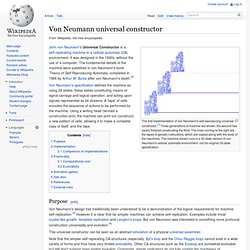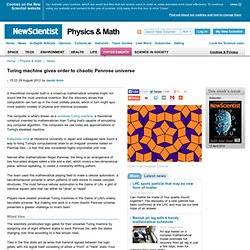

Von Neumann universal constructor. The first implementation of von Neumann's self-reproducing universal constructor.[1] Three generations of machine are shown: the second has nearly finished constructing the third.

The lines running to the right are the tapes of genetic instructions, which are copied along with the body of the machines. The machine shown runs in a 32-state version of von Neumann's cellular automata environment, not his original 29-state specification. John von Neumann's Universal Constructor is a self-replicating machine in a cellular automata (CA) environment. It was designed in the 1940s, without the use of a computer. The fundamental details of the machine were published in von Neumann's book Theory of Self-Reproducing Automata, completed in 1966 by Arthur W.
Von Neumann's specification defined the machine as using 29 states, these states constituting means of signal carriage and logical operation, and acting upon signals represented as bit streams. Purpose[edit] Implementation[edit] In 2004, D. C. First gliders navigate ever-changing Penrose universe - physics-math - 03 August 2012. Video: Glider discovered in Penrose tiles If someone asked you to walk in a straight line over a constantly shifting floor, you would probably declare it impossible after a few tries and a couple of grazed knees.

Researchers studying a version of this task inside a particular mathematical universe felt the same – but now a nimble traveller capable of navigating a clear path has emerged. The walk in question takes place inside a particular, irregular cellular automaton, a theoretical universe in which patterns of cells evolve, and appear to move, just by following simple rules. The traveller, meanwhile, is a highly repetitive object known as a glider. Its creation is an achievement because gliders were previously thought to exist only in regular cellular automata, such as the most famous one, the Game of Life – and because these objects are building blocks for more complex creations. – from nothing but these simple evolving cells.
Death sentence A few days later, Goucher had it. Reaction-diffusion - A cross-platform implementation of various reaction-diffusion systems. Turing machine gives order to chaotic Penrose universe - physics-math - 29 August 2012. A theoretical computer built in a mixed-up mathematical universe might not sound like the most practical invention.

But the discovery shows that computation can turn up in the most unlikely places, which in turn might spur more realistic models of physical and chemical processes. The computer is what's known as a universal Turing machine, a theoretical construct invented by mathematician Alan Turing that's capable of simulating any computer algorithm. The computers we use today are approximations of Turing's idealised machine. Katsunobu Imai at Hiroshima University in Japan and colleagues have found a way to bring Turing's computational order to an irregular universe based on Penrose tiles – a feat that was considered highly improbable until now.
Named after mathematician Roger Penrose, the tiling is an arrangement of two four-sided shapes called a kite and a dart, which covers a two-dimensional plane, without repeating, to create a constantly shifting pattern. Wired tiles More from the web. See how Turing accidentally invented the computer. MacGregor Campbell, contributor It's hard to do anything these days without a computer being involved in some way.

From credit card readers to traffic signals to the phone in your pocket, computers can perform all kinds of tasks thanks to different software programs. So how did the programmable computer come about? In this animation, we show you how Alan Turing came up with the idea while trying to solve a fundamental mathematical problem. By building his machine, he demonstrated that mathematics wasn't as perfect as many at the time believed, while also showing how powerful a computer could be. To find out more about Turing's legacy, check out our Instant Expert guide that explains how many of his ideas influenced modern technology. If you enjoyed this video, watch our other animated explainers to find out, for example, how the internet can read your mind, or the hidden equations that rule the world.